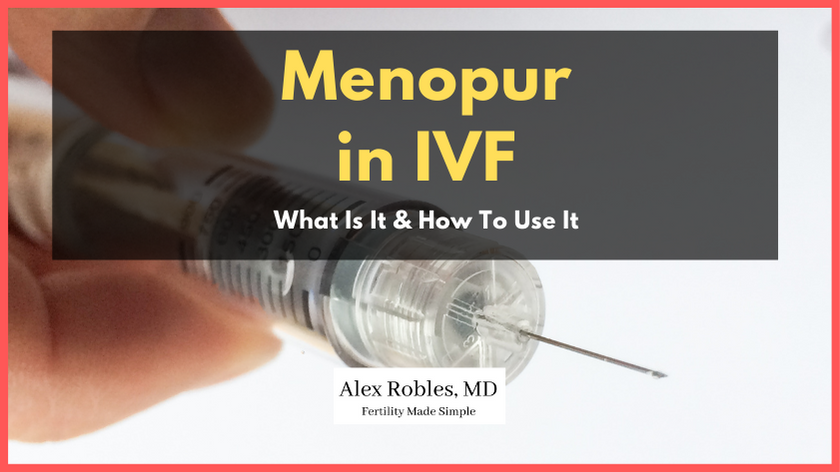Menopur (also known as human menopausal gonadotropin) is one of the key medications used in an in vitro fertilization cycle.
In this post, you will learn:
- What Menopur does in IVF and how it works
- How to take this injectable medication
- Side effects you can expect from using it
Let’s get started.

What is Menopur?
Menopur is a gonadotropin medication used for fertility treatments. It contains two hormones that are naturally produced by your pituitary gland- follicle-stimulating factor (FSH) and luteinizing hormone (LH).
These hormones help your ovaries produce a mature egg (inside of a follicle) and stimulate estrogen production.
What does Menopur do during IVF?
Menopur works by stimulating your ovaries to produce multiple follicles during an IVF cycle.
Your body will secrete just enough FSH and LH to produce just one follicle in a natural cycle.
In contrast, Menopur delivers these hormones directly to your body at a much higher dose than what naturally occurs.
As such, Menopur (in conjunction with another gonadotropin medication) will stimulate the production of multiple follicles and potentially many mature eggs.
Is It Necessary?
Menopur is the only medication that provides LH during an IVF treatment cycle.
However, it is not absolutely essential.
Some IVF patients do well with FSH injections only (Gonal F or Follistim). In these cases, the dose of FSH used is higher than a standard dual gonadotropin approach, usually ~450 IU of FSH.
There are even clinical trials comparing Menopur only versus FSH (alone or FSH + HMG) showing equally good IVF outcomes. [Study 1] [Study 2] [Meta Analysis]
How Do You Use It?
Menopur comes in powder form and must be mixed and dissolved with sterile saline before you inject it.
You do this by injecting 1 mL of sterile saline into the vial containing the Menopur powder. Then gently rotate the vial between your fingers for a few seconds until all particles have dissolved.
It is important not to shake the vial.
If you are using more than one vial, this dissolved solution can then be introduced into the next Menopur vial and the process repeated. For more detailed instructions, see this video.
You will then inject yourself with the Menopur solution with a subcutaneous needle once a day, usually in the stomach/ abdominal region.
Thankfully, it’s not a painful process.
Menopur is often used in an IVF cycle in conjunction with another gonadotropin medication (Gonal-F or Follistim).
How much Do You Need for An IVF Cycle?
The dose of Menopur needed in IVF depends on your age, body weight, AMH level, and how many follicles you are expected to develop during treatment.
The typical daily dose ranges from 75 IU (1 vial) to 300 IU per day (4 vials).
In general, the lower your ovarian reserve (low AMH), the higher your initial dose of Menopur will be.
As such, many reproductive endocrinologists argue that there is no benefit in exceeding 150 IU of Menopur per day (2 vials) if you are already using 300 IU of FSH.
How long do you take It For?
Typically, you will take Menopur every day during an IVF stimulation cycle until your follicles are ready to be retrieved.
Based on the speed at which your follicles grow, it is typical to take Menopur for about 8-12 days (the length of an IVF cycle).
In general, we like to see at least two mature follicles at 18 mm or larger before administering the hCG trigger shot for the egg retrieval.
What is the best time to take It?
The exact time you take Menopur isn’t as critical as the frequency in which you take it. In general, we recommend you take it at night, every 24 hours, starting on day two or three of your menstrual cycle.
You must pick a convenient time for you so that you can inject around the same time every day.
If you are late on a dose (about 30-60 min), it is usually okay to inject the missed amount as soon as you remember and carry on with your usual schedule.
Be sure to speak with your fertility clinic for specific guidance if you completely miss a dose or inject the wrong amount.
side effects To Be Aware Of
Possible side effects you may experience with Menopur include:
- Headache
- Nausea
- Abdominal pain and cramping
- Breast tenderness
- Fatigue
- Dizziness
- Pain at the injection site
- Redness and swelling at the injection site
The good news is, these common side effects are short-lived and improve quickly after discontinuation.
In rare cases, Menopur can increase the risk of ovarian hyperstimulation syndrome (OHSS). This condition is related to how strong of an ovarian response you develop during the treatment.
Symptoms of OHSS include abdominal distention, bloating, pain, shortness of breath, and rapid weight gain.
The use of a Lupron trigger can significantly decrease the risk of OHSS.
Another serious (albeit rare) complication of the use of fertility drugs is ovarian torsion.
You can learn more about the side effects of IVF medications here.
How long does Menopur stay in your system?
The half-life of menotropins is 11-13 hours.
This means that after ~12 hours, there is only 50% of the circulating medication still left in your system. After 24 hours, there is half of that left, so 25%.
After 36 hours, 12.5% remains, and so on.
Other Related Questions
Does Menopur help follicles grow?
Yes, the goal of all gonadotropin injections is to induce follicle growth. Depending on the dose used, you may have multiple ovarian follicles growing simultaneously in response to the Menopur.
What is the difference between Gonal F and Menopur?
Gonal-F is a gonadotropin medication composed of FSH only. Menopur is a combination of both FSH and LH.
Both are used in infertility treatment to induce follicle development.
Does It Improve egg quality?
It is unlikely that Menopur affects egg quality. Unfortunately, egg quality may be genetically determined, and we don’t have any proven strategies to improve egg quality.
Does It increase the chances of pregnancy?
If used as part of an IVF cycle to yield multiple follicles, ovarian stimulation with gonadotropins can increase the chance of pregnancy compared to no treatment.
However, a high egg yield does not guarantee a pregnancy. Similarly, gonadotropin injections do not guarantee a high number of eggs either.
Success rates are always determined by the entire picture.
How much does It cost?
At the time of the writing, 75 IU of Menopur (1 vial of powder) costs between $197-261. Prices are always subject to change.
Conclusion
Menopur is a stimulation medication used in the IVF process to provide the hormones necessary for inducing ovarian follicular growth.
You will take your IVF stimulation medications for about 8-12 days, and you can expect mild to moderate side effects throughout the length of treatment.
However, these side effects should slowly improve after stopping the medication.
If you have any other questions about your IVF journey, check out my other resources below!
Make An Appointment With Dr. Robles To Discuss Your Fertility Options Today!

Alex Robles, MD
Dr. Alex Robles is a Spanish-speaking Latino-American Reproductive Endocrinologist and Infertility specialist in New York City, and a board-certified OBGYN. He has a special interest in health, lifestyle, & nutrition. Make an appointment with Dr. Robles to discuss your fertility options today!
References
- Lefebvre J, Antaki R, Kadoch IJ, Dean NL, Sylvestre C, Bissonnette F, Benoit J, Ménard S, Lapensée L. 450 IU versus 600 IU gonadotropin for controlled ovarian stimulation in poor responders: a randomized controlled trial. Fertil Steril. 2015 Dec;104(6):1419-25. doi: 10.1016/j.fertnstert.2015.08.014. Epub 2015 Sep 8. PMID: 26361207.
- Pacchiarotti A, Sbracia M, Frega A, Selman H, Rinaldi L, Pacchiarotti A. Urinary hMG (Meropur) versus recombinant FSH plus recombinant LH (Pergoveris) in IVF: a multicenter, prospective, randomized controlled trial. Fertil Steril. 2010 Nov;94(6):2467-9. doi: 10.1016/j.fertnstert.2010.04.035. Epub 2010 May 26. PMID: 20537626.
- Witz CA, Daftary GS, Doody KJ, Park JK, Seifu Y, Yankov VI, Heiser PW; Menopur in GnRH Antagonist Cycles with Single Embryo Transfer – High Responder (MEGASET-HR) Trial Group. Randomized, assessor-blinded trial comparing highly purified human menotropin and recombinant follicle-stimulating hormone in high responders undergoing intracytoplasmic sperm injection. Fertil Steril. 2020 Aug;114(2):321-330. doi: 10.1016/j.fertnstert.2020.03.029. Epub 2020 May 13. PMID: 32416978.
- Jee BC, Suh CS, Kim YB, Kim SH, Moon SY. Clinical efficacy of highly purified hMG versus recombinant FSH in IVF/ICSI cycles: a meta-analysis. Gynecol Obstet Invest. 2010;70(2):132-7. doi: 10.1159/000308458. Epub 2010 Apr 10. PMID: 20389096.
- Keye WR, Webster B, Dickey R, Somkuti S, Crain J, Scobey MJ. Subcutaneously administered Menopur, a new highly purified human menopausal gonadotropin, causes significantly fewer injection site reactions than Repronex in subjects undergoing in vitro fertilization. Reprod Biol Endocrinol. 2005;3:62. Published 2005 Nov 9. doi:10.1186/1477-7827-3-62
